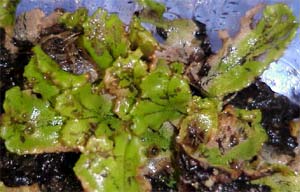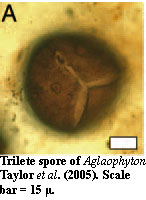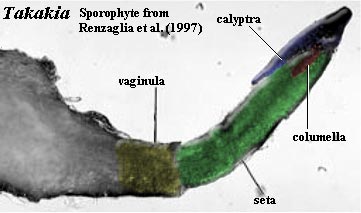
All material by ATW may be used under the terms of a
Public Domain Dedication.
| Glossary | ||
| Plants | Glossary T-Z |
| Plant | Plant | Time |

Terete "Smooth, cylindrical and tapering. Often used in describing vascular cells in plants (esp. xylem cells)." Glossary.
Thallus term given to the body of a lower plant which has no recognizable shoot, root, leaf regions. Most of the things this term is used to describe are not even plants, e.g. lichen. However, the term does apply to plants like the liverwort shown in the image. Image from the Majors Biology site of Tyler Junior College (Texas).
Thalloid with reference to a growth habit, recumbent, spreading along the substrate (e.g., mosses and liverworts); as opposed to axial, growing upward from the substrate (e.g., trees).
Thallophyte an organism not differentiated into shoot and root, the cells of which have a cell wall; originally used for bacteria, Fungi and algae.
Toothed margin (leaves) margin having projections or serrations with pointed apices, indented less than one quarter of the distance to the midvein or long axis of the leaf; compare entire margin and lobed margin leaves.
Tracheid This definition used to be so simple. Its like this. In the good old days, xylem had two kinds of tube-like systems, vessels and tracheids. Vessels were wide, open, short and dead. Tracheids were narrow, closed-ended, long, and mostly had some living cell associated with them. Then came Carlquist & Schneider (2002). These folks unfairly used actual observations, rather than generations of classroom dogma. This was an utterly rotten thing to do because it messed up a lot of perfectly good, if slightly faded, lecture notes. C&S pointed out that there are at least six character states involved, and that any given plant may have tubular things of several different kinds falling almost anywhere in that morphospace. To complicate matters further, in plants with vessels, the tracheids may have specialized as structural support tissues (biological rebar). In plants without vessels, tracheids often differ strongly between vessel-like earlywood and latewood tracheids. The morphological characters identified by C&S are shown in the figure.

Tracheid types early plants developed several distinct types of tracheids. See Friedman & Cook (2000); Kenrick & Crane (1997). These are described in the figure:

Tracheophyte plants with true vascular tissue, i.e. xylem and phloem;. Includes all land plants higher than bryophytes (mosses) and liverworts.

Translocation the process whereby solutes are transported through the phloem. Unlike xylem, phloem is essentially a chain of living cells. The most widely accepted explanation for translocation of substances in the phloem is the Münch pressure flow hypothesis. The proposed mechanism is as follows: a high concentration of solute (e.g., sugars) is loaded into cells of the phloem, presumably by active transport, at locations, such as a leaf, where sugars are produced by photosynthesis. The high solute concentration in the phloem cell creates an osmotic gradient which draws water into the phloem. The resulting high turgor pressure causes flow to occur. If the dissolved sugars or other chemicals carried along with the sugars are removed from the phloem at another place in the tree for use (a sink such as a root or fruit), the decline in concentration of sugar causes water to move out of the phloem cells. Because water is moving in at a source and out at a sink, there is a mass flow of water and substances in the phloem.
Transverse section cross section. A section perpendicular to the main axis of the plant or organ.
Triarch consisting of three; for example a triarch stele has three lobes.
Trilete a term used to describe spores with a 'Y'-shaped suture. This is believed to represent the attachment point of a spore tetrad (group of 4). "This scar results from the splitting of the spore mother cell into four equivalent reproductive cells in such a manner that the four are all in contact at a single point. When these cells separate, they carry a remnant of the point of commonality and the lines of contact with adjoining cells, forming the "Y" shaped mark or suture. The same effect can be produced by pressing four balls of clay or plasticine tightly together, then carefully separating them again." Earth History Research Center. Image from Taylor et al. (2005).
Turgor see osmotic pressure.

Vaginula in mosses, a derivative of the archegonium forms a hard, protective epigonium around the developing sporophyte. Later the epigonium breaks up, but the sporophyte retains a conical "dunce cap" or calyptra over its distal end and sometimes a ring around the base. The term calyptra refers to the "dunce cap," and the piece of the epigonium retained around the base (if any) is the vaginula.
Vascular relating collectively to the conductive plant tissues, xylem and phloem. Analogous vascular tissues in bryophytes are referred to as hydroids and leptoids, respectively.
Venter swollen basal region of the archegonium where the sporophyte develops in bryophytes.
Wood ray a radially oriented tier of parenchyma cells that conducts food, water, waste products and other materials laterally in stems and roots of woody plants; rays are usually continuous across the vascular cambium between the secondary phloem and xylem.
Xylem Vascular tissue specialized to transport water and solutes. Generally composed of lignified (woody) dead cells. Unlike phloem, which does not accumulate but instead is shed with the dead bark, the old xylem is retained, may be used to conduct water for a few years, and eventually just provides structural support as the tree grows larger. At least 90% or more of the trunk of a tree is xylem or wood.
Xylem, primary see primary xylem.
Xerophyte a plant well adapted to withstand prolonged drought. The typical xerophyte is a deciduous shrub with tiny leaves and a shallow root system that extends well beyond the crown of the shrub.
Zygote according to Wikipedia, from Greek ζυγωτóς, zugootos, "joined" or "yoked", from ζυγοῦν, zugoun, "to join" or "to yoke". We believe this etymology is absolutely correct. The term refers to the fertilized egg and the earliest stages of development of the embryo. In botany, this represents the earliest developmental stages of the diploid, sporophyte generation.
checked ATW050811
modified ATW090530